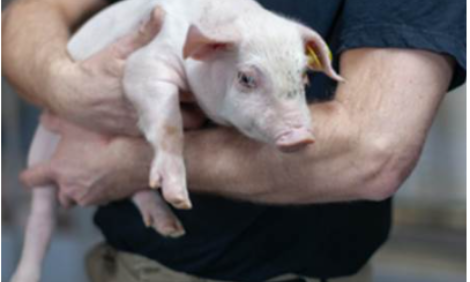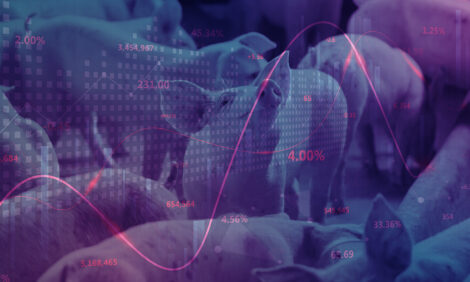



US Pork Outlook - January 2011
Commercial pork production is expected to be slightly higher in 2011 than last year, according to the latest Livestock, Dairy, and Poultry Outlook from the USDA's Economic Research Service.Highlights
Lower December 1 inventories and farrowing intentions reported in the December 1 Quarterly Hogs and Pigs report are expected to be offset by year-over-year higher litter rates and slightly higher dressed weights, to yield a 0.5 per cent increase in 2011 commercial pork production.
Slightly Higher 2011 Pork Production Expected, as Productivity Gains and Higher Dressed Weights Offset Lower Inventories and Farrowings
In a US animal-protein market environment now dominated by upside feed-price risk, the Quarterly Hogs and Pigs report released by USDA on 27 December 2010, showed lower swine inventories and lower farrowing intentions for the first half of 2011. At a minimum, lower inventories and farrowing intentions indicate a degree of caution on the part of hog producers with respect to how profitability might be affected by higher feed costs. The report indicated that the December 1 inventory of market hogs was 0.83 per cent lower than a year ago. The report also indicated that producers have pared back breeding animal numbers compared with a year earlier – December 1 inventory of breeding animals was 1.23 per cent lower than on 1 December 2009. The lower breeding inventory, combined with estimated year-over-year higher fourth-quarter sow slaughter (net of imported culled Canadian breeding animals), suggests that some producers have responded to higher corn and soybean meal prices – and to expectations that high prices will continue into the future – by reducing breeding numbers, thereby limiting exposure to the lower returns that higher feed costs often imply.
The report also showed lower producer farrowing intentions for the first half of 2011. The second set of producer intentions for the December-February quarter indicates that farrowings will be about one per cent lower than a year earlier. First intentions for the March-May quarter are 2.25 per cent below the same period last year. Combined producer intentions in the December report indicate that first-half 2011 farrowings could be about 1.4 per cent lower than in the same period last year.
While smaller breeding animal inventories and lower farrowing intentions often translate into lower pig crops, continued gains in sow productivity are expected to largely offset lower farrowing numbers in 2011. Moreover, continually improving swine genetics and enhanced nutrition management practices are expected to continue to move average dressed weights slightly ahead of last year’s estimated average of 203.5 pounds per carcass. Hog weights are expected to average slightly ahead of last year’s average, although recent weight increases are not expected to be sustained through the year. This year’s commercial pork production is expected to be 22.5 billion pounds, about 0.5 per cent higher than production in 2010.
Exports Strong in November
November pork exports totaled more than 406 million lbs, 6.7 per cent higher than a year ago. The largest export shipments in November were made to Japan, Mexico and Canada. Exports to Japan (10.2 per cent higher than last November) and Mexico (30.4 per cent higher) were substantially above a year ago, while shipments to Canada were 8.8 per cent below November 2009. Fourth-quarter exports are expected to be 1.15 billion lbs, or 2.95 per cent ahead of the same period in 2009. While high US pork prices are expected to persist into 2011 and to slow growth in the demand for US pork, total 2011 pork exports are expected to increase by more than nine per cent above 2010 shipments. US imports of pork products in November were about 74 million lbs, 0.4 per cent above a year ago. Canada (82 per cent of imports) and Denmark (7.4 per cent) together supplied more than 88 per cent of imported pork products in November. Smaller suppliers – Mexico (2.7 per cent), Poland (3.4 per cent) and Italy (1.7 per cent) – accounted for most of the remainder. Total 2010 imports, expected to be 880 million lbs, would constitute about 4.6 per cent of US domestic pork disappearance, a favourable comparison with the 10-year average of 5.2 per cent. Pork imports for 2011 are expected to be 900 million lbs, an increase of 2.3 per cent year-over-year.
US imports of live swine were about 465,000 head in November, a decline of more than two per cent from November 2009. The decline in total numbers was tempered by year-over-year increases in both categories of breeding animals, and by a three per cent increase in segregated early-weaned animals—animals weighing less than 7kg per head. Continued strong US hog prices will likely draw these categories of animals into the United States.
December Retail Prices Down Sharply as Bacon Prices Ease
December retail pork prices were $3.19 per lb, down sharply from $3.32 in November. The Bureau of Labor Statistics data, upon which retail prices are based, suggest that easing bacon prices likely account for most of the drop in retail pork prices. Retail pork prices are expected to remain in the mid-to-high $3.20’s per lb for 2011.
Further Reading
| - | You can view the full report by clicking here. |
January 2011








